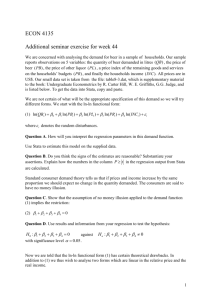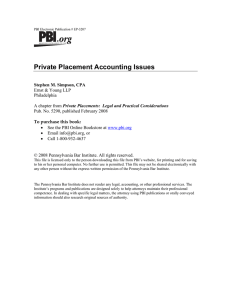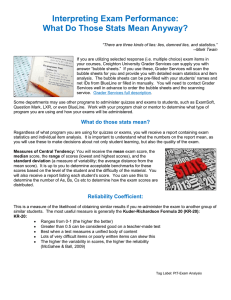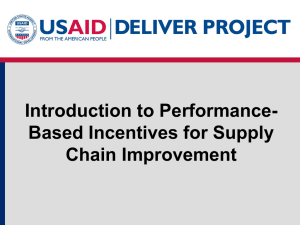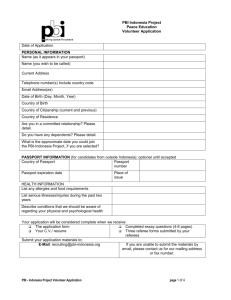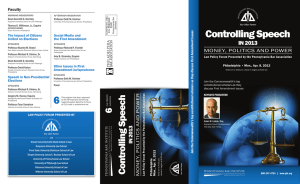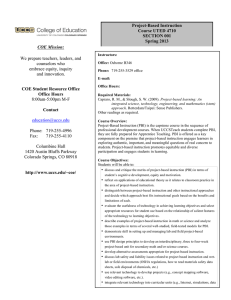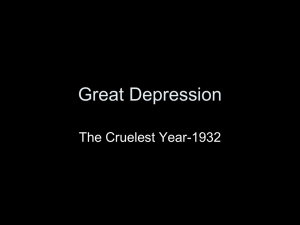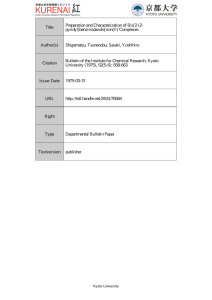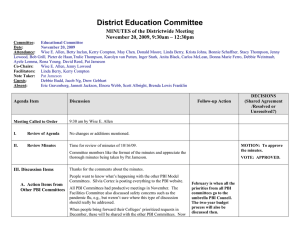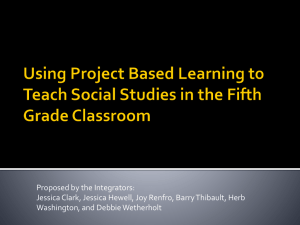Download: UTeach Course Overview: Project
advertisement
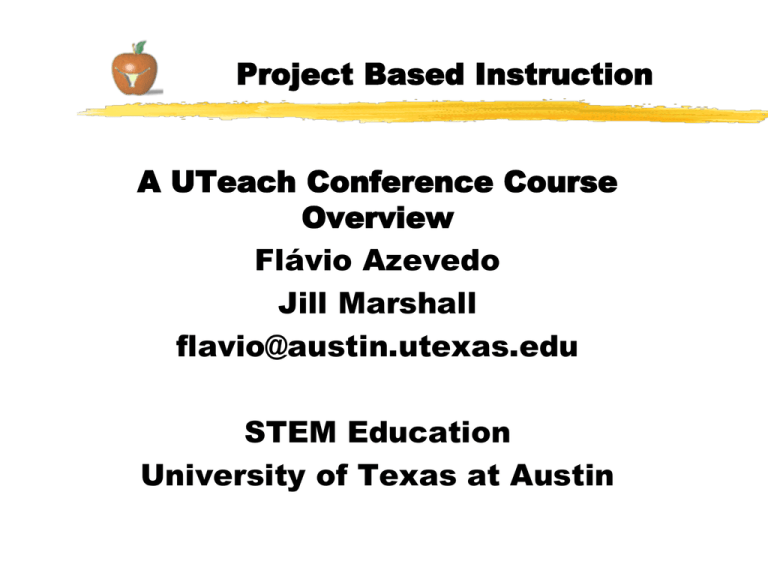
Project Based Instruction A UTeach Conference Course Overview Flávio Azevedo Jill Marshall flavio@austin.utexas.edu STEM Education University of Texas at Austin Project Based Instruction What do you know? What do you want/need to know? What is PBI? In project-based science classrooms, students investigate and collaborate with others to find solutions to real-world questions. Using technology… make products to show what they have learned. This method of teaching science motivates young learners to learn and explore, and it meets the national goals for and standards of science education. Because project-based science parallels what scientists do, it represents the essence of inquiry and the nature of science. (Krajcik & Czerniak, 2007, p. 25) Why PBI? In PBI, students are prepared to do things they might actually do in life. Research has demonstrated that students in project-based learning classrooms get higher scores than students in traditional classrooms… (Krajcik & Blumenfeld, 2006, p. 318) Essential elements of PBI Some sort of driving question or problem, for which the answer is not readily known. Complex, extended, collaborative, situated inquiry. Data gathering from multiple sources required for solution. Scaffolding in the form of benchmark lessons, opportunities for assessment, social structure Use of cognitive tools History of PBI Originates in home project movement beginning in vocational agricultural ed in the early 20th Century. Looked to the immediate needs and interests of students in order to engage them in the “hearty purposeful act” (Kilpatrick, 1918, p.320). But “did not teach future citizens what they needed to know” (Charters, 1922 cited in Kliebard, 1995, p.141) and “that learning limited to this method was too discontinuous, too random, and too haphazard, too immediate in its function” (Bode, 1927, cited in Kliebard, 1995, p.152). Vanished by the 1950s. The new PBI Undergoing a resurgence with student-centered reforms Outcomes-driven, theoretically-grounded design process addresses main objections (lack of focus; cognitive overload) Tied to appropriate learning goals, scaffolding (Barron, B., Schwartz, D. L., Vye, N. J., Moore, A., Petrosino, A. J., Zech, L., Bransford, J.D.1998). Overview Course originally developed by Tony Petrosino Housed in Dept of Curriculum & Instruction Field-based course: 3 – 4 day field experience, plus several classroom observations. Master teacher sets up field experience Mentor teachers paid stipends Capstone course Prerequisites: STEP 1-2, Knowing and Learning, Classroom Interactions* Last course before Apprentice Teaching Preliminary portfolio due during PBI Course Goals 1) To support the UTeach student’s development by building a deep understanding of PBL, including differentiating between strong and weak theoretical approaches to PBL, and between PBL and other inquiry-based approaches. Course Goals 2) To enhance UTeach students’ ability to design or adapt activities, lesson plans and a complete project-based unit following theoretical frameworks of PBL Course Goals 3) To build UTeach students’ capacity to critically reflect on their own and others’ lesson plans and enactment. Course Goals 4) To increase UTeach students’ ability to measure student learning through the appropriate use of formative and summative assessment, and respond instructionally to the assessment information. Course Goals 5) To incorporate and synthesize work from Knowing and Learning, Classroom Interactions, and STEP courses into a meaningful capstone experience integrating theory and practice. Course goals Students experience an engineering design challenge and evaluate this mode of instruction. PBI and equity Contextualized around your own students’ experiences Everyone gets to do high-level thinking, develop 21st century skills Need-to-know created for facts and skills Addressing the “other 90%” Major components Read and discuss literature on PBI Experience and/or learn about several PB units (Design challenge) Create and implement a project-based unit at a local high school (groups of 2-3) Analyze the implementation and suggest improvement (individual, written assignm’t) Design a 2-4 week unit based on topics in state standards in their AT semester Components of PBI Field Experience Theory Reflective Analysis Unit Development Semester Flow – Spring 2012 Weeks 1-4 Weeks 5-9 Weeks 10-15 Presentation and analysis of PB units (including experiencing one as learners) Plan, create, and implement field experience unit in close collaboration with teacher Analysis and reflections on field experience ----------------------Portfolio Engagement with literature (including creating and critiquing examples) Design of final project: 2-4 week unit*, additional literature *planned for AT Logistics and Classroom Practices & Policies Class meetings 3 hours weekly Outside preparation (7-10 hours, some during class) Class Agenda and Activities displayed in PowerPoint and archived on Blackboard/Canvas Course assignments (guidelines, rubrics), resources posted on Blackboard/Canvas Online discussion board for reading accountability, input to discussion Field experience Format has varied historically Master teacher arranges placement Does it have to be a PB school? No, but students should have access to PB instruction to observe Meeting between students, mentor teachers; observations Spring ‘14 one 90-min class period, field trip (school day), two 90min class periods Student groups identified sites for their field trip E.g, natural history museum; local caverns, F1 track… Components of unit design process (Krajcik, McNeill, & Reiser, 2008) Identify and unpack standards Generate learning performances Create concept maps showing relationships Craft driving question Iteratively, define anchor activity and final product Craft assessment and learning activities to reach learning performances and scaffold final product Create calendar --------------------- Upload all to webpage Driving Questions feasible worthwhile (aligns with standards) contextualized (real-world) meaningful (interesting) Ethical (Krajcik & Blumenfeld, 2006) Sustainable (Krajcik & Czerniak, 2007) “How can I smell things at a distance?” “How can machines help me build big things?” Anchoring experience can make the DQ more meaningful Anchoring experience Bransford et al., 1990; Kumar, 2010 A story (video) of a situation that puts a problem in real-world context Scaffolds students, embedded information, models approaches Great resource: Petrosino and Dickinson website (http://www.edb.utexas.edu/anchorvideo/howto.php) Final product Performance (presentation) or product (wildlife sanctuary plan, physical or computer model, report, video, etc.) Addresses driving question Embodies students’ learning Supports students in developing understanding Encourages connections between ideas, disciplines Realistic Resources Example projects at http://www.uteach.utexas.edu/PBI Blog at http://pbispring2012.wordpress.com/ Legacy cycle webpage at http://www.edb.utexas.edu/visionawards/petrosi no/ Anchor video (Petrosino) http://www.edb.utexas.edu/anchorvideo/theory.p hp
